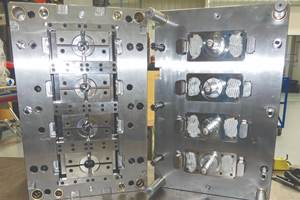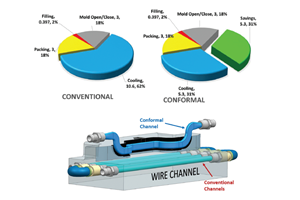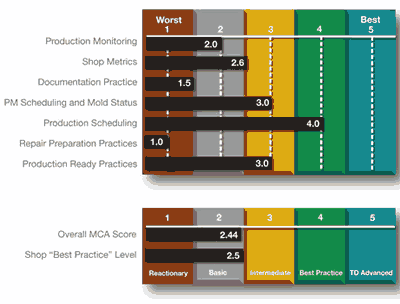Acquiring Maintenance Discipline
Maintenance discipline is just as much a factor of our working environment as it is our individual character that controls an internal drive toward performance excellence.
Discipline. Many people don’t even like the sound of the word. It resonates something repressive, controlling, unpleasant and harsh. There are several Webster definitions for discipline, but a good one is “having the ability to do what is hard when it is the hardest to do.” Unfortunately, some kind of discipline is required in almost everything we do. The lack of this character trait has been the downfall of many good people, ideas and opportunities. Why is it so hard to attain? Because it requires a skill not usually acquired until the latter stages of our lives—after we have learned too many lessons the hard way.
Many U.S. companies shut down and/or move overseas because of the lack of it. Sure, politics has played an important role in stunting the growth of businesses large and small with unfair trade agreements, tariffs, taxes and regulations. But other factors closer to home include a lack of simple, everyday workplace discipline in performing prescribed tasks, resulting in the general diminishing perception concerning the value of shop floor trade skills. Reversing this exodus to foreign countries will not only require major political moves, but also can be affected by a single shop floor employee simply doing his job in a more efficient, effective and disciplined manner. In the extremely expensive field of mold repair—not doing so can most definitely be the last straw.
Discipline in Maintenance
For a repair technician, it is the ability to follow prescribed administrative processes such as SOPs, BOPs, work instructions, etc. that provide instruction and continuous training to perform duties in a controlled and systematic way. By operating in this manner, results are more consistent and predictable. They allow us to make smart decisions behind a bench, in turn, allowing a company to optimize labor and tooling costs. Lacking a formalized, strategic plan for a repair tech to follow leaves them completely on their own to determine how best to spend their time (critical labor hours) along with thousands of dollars of company funds (tooling). It makes no sense to strand a repair tech at his bench, then pay him a low-ball hourly rate to control these thousands on a daily basis—one repair at a time—and we haven’t even begun to consider maintenance decisions that also directly affect part quality.
Typical American skilled tradesmen are by nature competitive, proud, freelancers. The question then is how to harness these individual qualities that separately have good moments, but jointly can achieve great accomplishments.
From a hands-on perspective, discipline at the bench means performing tasks using best-practice techniques, and with tools and methods learned through experience with little or no supervision. A disciplined craftsman performs in this manner simply because his gut tells him it is the right thing to do. He knows working in a systemized approach—though perhaps not always as interesting—will yield profitable results by reducing costly mistakes on expensive mold components that occur during the disassembly, troubleshooting, cleaning and assembly stages of repair or anything bench-related that causes production to be halted and a mold repaired before it’s scheduled.
Value in Structure and Discipline
With all of the American ingenuity and plastics processing technology at our disposal, many toolroom supervisors and managers still lack the ability—or discipline—to see the value of a structured and formalized maintenance roadmap for repair technicians. Assuming—incorrectly—that the ambiguous, illegible and incomplete journal entries of work order systems, coupled with the fear of losing their jobs, will motivate a repair technician to automatically perform at higher levels of craftsmanship. This management philosophy just does not work.
Having spent the first couple of years out of the military, a somewhat rebellious and undisciplined toolmaker, I relished the absence of systemization and real accountability in our 14-man toolroom. With no plan to follow, my work ethic on a given day was a reflection of my mood. Although this attitude took a 180 when I hit my thirties, this maintenance style is still in full force today among many who feel stuck at a workbench with no viable means to measure their worth to the company or themselves through proof of a job well done. A craftsman might not be an accountant, but the majority still likes to see the discipline that drives their troubleshooting skills, attention to detail and increasing skill level reflected in a report that spins these intangibles into dollars and cents—the ultimate American scorecard.
Summary
Maintenance discipline is just as much a factor of our working environment as it is our individual character that controls an internal drive toward performance excellence. A structured approach is not only necessary to achieve continuous improvement in our processes and skills, but a means to accurately measure this improvement over time. A structured approach to maintenance provides order and accountability to common toolroom tasks that are viewed subjectively by apprentice and journeyman repair personnel alike.
Acquiring/improving maintenance discipline will not only save companies thousands of manufacturing dollars, but will provide motivational tools that will yield higher personal standards, increased morale and a renewed dedication to the job through the knowledge that skilled bench work is recognized and appreciated by our administrative leaders. Bottom line? Maintenance discipline is prerequisite to the health, prosperity and long-term success of any moldmaking and molding company.
Related Content
Precision Welding Services Offer Rapid Turnaround Mold Repair and Reduced Molder Downtime
X-Cell Tool & Mold relies on outsourced, high-quality welding repairs from Lewis-Bawol Welding to ensure its customers' molds are back in production quickly and affordably.
Read MoreWhat Is Scientific Maintenance? Part 1
Part one of this three-part series explains how to create a scientific maintenance plan based on a toolroom’s current data collection and usage.
Read MoreHow to Use Thermal Management to Improve Mold Cooling
A review of common mold cooling issues and possible solutions, including 3D printing applications.
Read MoreThe Ins and Outs of Hot Runner Temperature Control
A training checklist that explains the why and how of proper hot runner temperature control and system management.
Read MoreRead Next
Beyond the Classroom: Mold Maintenance Products That Work
Leaving injection mold maintenance to chance is a costly oversight. Using standardized methods of improvement, as explained here, can yield real change to company practices as well as significant returns on a company’s tooling investment.
Read MoreReasons to Use Fiber Lasers for Mold Cleaning
Fiber lasers offer a simplicity, speed, control and portability, minimizing mold cleaning risks.
Read MoreHow to Use Strategic Planning Tools, Data to Manage the Human Side of Business
Q&A with Marion Wells, MMT EAB member and founder of Human Asset Management.
Read More



















